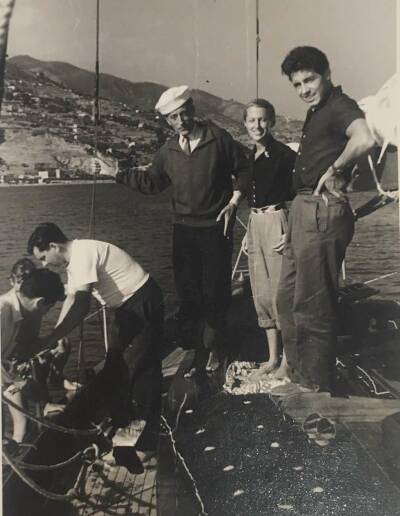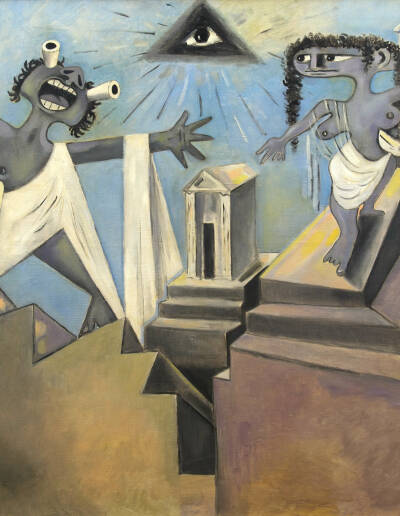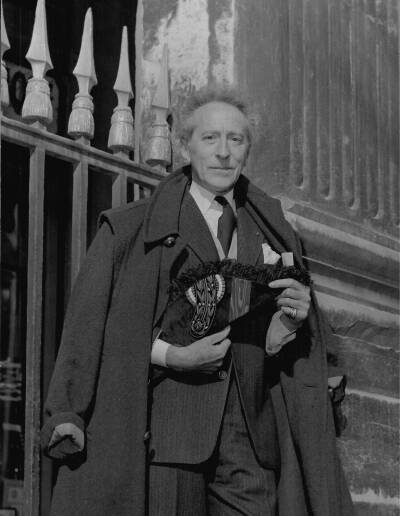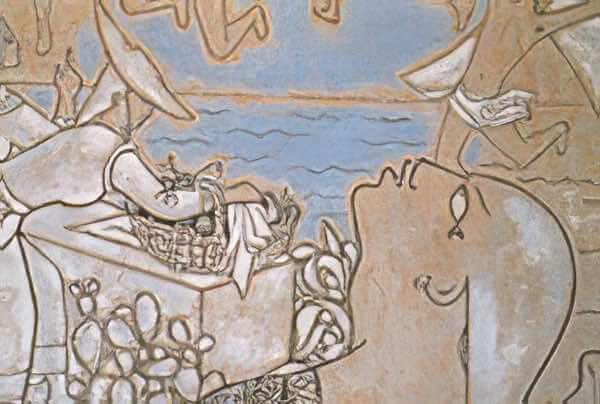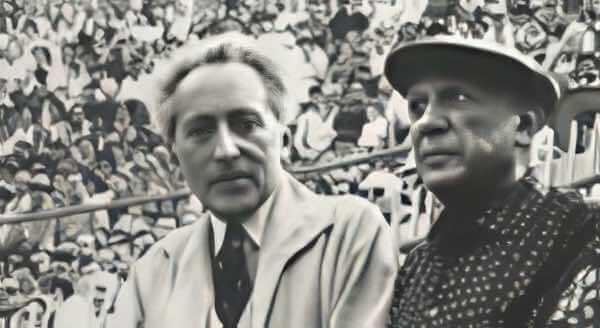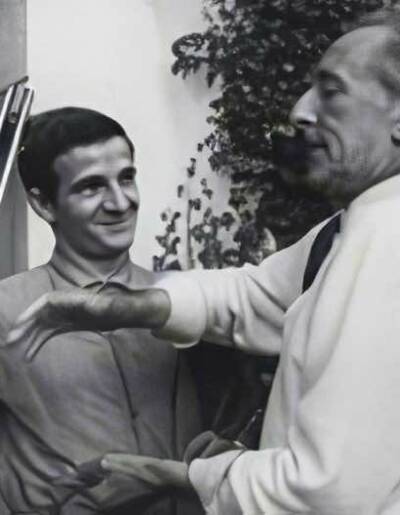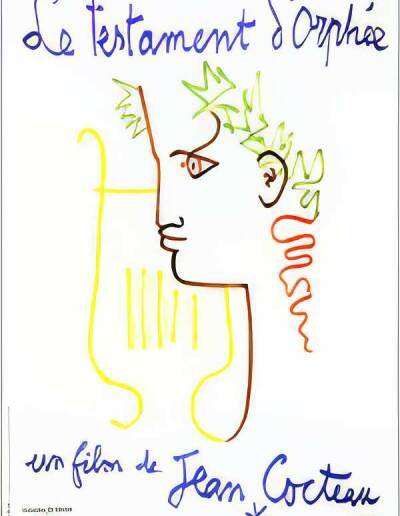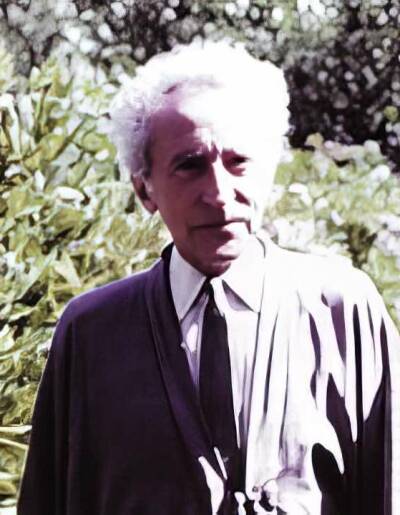At the beginning of the year, Cocteau records a series of radio interviews with André Fraigneau, including Entretiens autour du cinématographe – his interlocutions on the cinema. In April, he is elected president of the Union of Authors and Composers. He travels to Italy with Francine Weisweiller and Edouard Dermit, visiting Rome, Calabria and Sicily. In July, on Edouard Dermit’s urging, Cocteau starts a new journal, Le Passé défini (Past Tense). In August, Dermit becomes Cocteau’s sole legatee. Cocteau, who has painted profusely since the beginning of the year starts work on a new play – Bacchus. At the end of July, he returns to Santo Sospir. During the second half of August, he cruises to the Italian coast on board Francine Weisweiller’s yacht, the Orphée II. From September 11th to 26th, Cocteau goes to Paris and then Milly before returning to Santo Sospir, where he stays until October 30th. Whilst there, he devotes time to painting, meets with Picasso on several occasions, works on Bacchus and prepares a new film – La Villa Santo Sospir. On December 23rd, Bacchus premieres at the Théâtre Marigny. In "A letter to Jean Cocteau" published in the December 29th edition of Le Figaro littéraire, François Mauriac attacks the play and accuses its author of blasphemy. On the 30th, Cocteau responds in France-Soir, with the article "Je t’accuse!" ("I Accuse You!").
In January, on a tour of Germany, Cocteau visits Hamburg, Düsseldorf, Augsburg and Munich. He presents Orphée (Orpheus) and Villa Santo Sospir. An exhibition of his drawings, paintings and tapestries opens in Munich. In February, an exhausted Cocteau returns to Santo Sospir. He sees Colette and Matisse and writes Journal d’un inconnu (Hand of a Stranger). At the end of April, he returns to Paris and Milly to prepare for the première of Oedipus Rex at the Théâtre des Champs-Elysées. On opening night, Stravinsky conducts the orchestra but reactions to the work are mixed. From June 10th to July 1st, Cocteau travels to Greece with Francine Weisweiller and Edouard Dermit. He writes Le Chiffre sept (The Number Seven). In September, an exhibition of his graphic works opens in Berlin. He visits Arno Breker. Le Chiffre sept is published.
An exhibition of his paintings, drawings and tapestries opens at the galerie des Ponchettes in Nice. During the second half of March, Cocteau gives a series of lectures in Turin, Genoa, Milan and Rome. Francine Weisweiller and Dermit accompany him. In April, he goes to Cannes for the Film Festival. As president of the jury, he must attend every screening. Appogiatures is published. On May 9th, Cocteau goes to Munich for the debut performance of the ballet La Dame à la licorne (The Lady and the Unicorn). On May 27th he goes to Rome for an exhibition of Picasso’s works. He spends the intervening period at Milly and Paris. He returns to Santo Sospir in June and spends the month of July in Spain with the Weisweillers and Edouard Dermit. They visit Barcelona, Madrid, Toledo, Malaga, Torremolinos, Grenada and Gibraltar. Cocteau attends numerous corridas and meets Manolete and Dominguin. He also discovers flamenco. During September and October, he works on poems that will be included in Clair-obscur (Twilight). He writes a presentation for the concert by the Six and attends the performance at the Théâtre des Champs-Elysées. He leaves for Madrid for the Spanish opening of the film Orphée (Orpheus). He meets Dali.
Cocteau spends the first half of January in Milly and Paris where he has numerous appointments on the radio and at the theatre. He spends a few days in Santo Sospir then, during February and March, he goes to Kitzbühl, Austria to rest. From March 18th to April 9th, he goes to Cannes for the Film Festival where again he is president of the jury. From April 28th to May 9th, Cocteau travels to Madrid and Seville and attends several corridas. On his return to Paris and Milly, he works on the Corrida du 1er mai (The Corrida of the 1st of May). On June 10th, Cocteau suffers a myocardial infarction. He is hospitalised until July 16th. He convalesces at Santo Sospir where he paints and corrects the proofs of Clair-obscur (Twilight) which will be published at the end of October. He takes an interest in flying saucers and extraterrestrials. In November, he returns to Paris and Milly. He learns the techniques of pastel.
On January 11th he is elected to Belgium’s Royal Academy of French Language and Literature. On March 3rd, Cocteau is elected to succeed Jérôme Tharaud at the Académie française in the first round of voting. His induction takes place on October 20th and it is André Maurois who responds to his speech. Cocteau is in Paris during February for an exhibition of his pastels at the Galerie Lucien Weill in Rue Bonaparte. He then goes to Saint-Moritz with Francine Weisweiller. In May, an exhibition of 180 of his pastels opens in Rome. He again spends the summer at Santo Sospir.
In March, Cocteau goes to Brussels for a new production of La Machine à écrire (The Typewriter). The production will later be performed at the Comédie-Française. He begins the task of decorating the chapelle Saint-Pierre in Villefranche. In April, Poèmes 1916-1955 – a new anthology of his poetry – is published. On June 12th he is made a Doctor honoris causa of Oxford University. On his return to Paris, he records Les Entretiens sur le musée de Dresde (Discussions on the Museum of Dresden) with Aragon. The recordings will be released the following year. He returns to Santo Sospir where he remains until early November. From September 27th to October 31st an exhibition of his photographs entitled Images de Jean Cocteau goes on show at the Galerie Henri Matarasso in Nice. An album of the exhibition is published. Cocteau continues decorating the Chapelle Saint-Pierre and agrees to decorate the registry office at Menton Town Hall. At the end of November, he returns to Paris and Milly for a month. He spends Christmas at Santo Sospir.
Cocteau finishes decorating the chapelle Saint-Pierre. He learns to make pottery at the Madeline-Jolly studio in Villefranche. A period of new poetic research results in Paraprosodies. He attends bullfights in Nîmes and in Arles with Picasso.
Cocteau’s sister Marthe dies on January 13th. At Santo Sospir, he works on Testament d’Orphée (Testament of Orpheus) despite the difficulties finding financing for the project. Paraprosodies précédées de 7 dialogues (Para-prosodies preceded by 7 dialogues) is published. He travels to Rome in mid-April, Paris in early June, then to Vienna for a production of Oedipus Rex, conducted by Karajan. In July, he goes to Venice with Edouard Dermit and Francine Weisweiller. Whilst there, he takes a training course at a Murano glass factory. He returns to Paris for the November 14th opening of an exhibition of his pottery at the Galerie Lucie Weill. At the end of December, he returns to Santo Sospir.
During rehearsals for a production of La Voix humaine (The Human Voice) in Nice, Cocteau contracts haemoptysis and is ordered to rest. As a result, he is unable to attend performances of the ballet La Dame à la licorne (The Lady and the Unicorn) at the Paris Opera, and La Voix humaine (The Human Voice) with Denise Duval at the Opéra-Comique. He starts to write Le Requiem in bed. Poésie critique I (Critical Poetry I) and Gondole des morts (Gondola of the Dead) are published. He spends a period of convalescence in Saint-Moritz before returning to Paris for Edouard Dermit’s first exhibition of paintings at the Galerie Montmorency. Back in Milly, he embarks on a project to decorate the Chapelle Saint-Blaise-des-Simples. He then returns to Santo Sospir until early July. In September, he begins shooting Testament d’Orphée (Testament of Orpheus) first in Les Baux-de-Provence then in Nice. On November 4th, he plays the role of narrator in the London production of Oedipus Rex. The performance is conducted by Stravinsky. He remains in London to decorate the church of Notre-Dame-de-France. He returns to Milly on November 21st and spends Christmas and New Year at Santo Sospir.
A second volume of critical poetry – Poésie critique II- is published. On February 10th, Le Testament d’Orphée (Testament of Orpheus) is screened in Paris. Cocteau travels to Saint-Moritz. On April 23rd, the chapel in Milly is inaugurated, followed on May 6th by the church in London. In June, Cocteau is elected to succeed Paul Fort as prince of poets – an event that sparks a rancorous debate that will last throughout the summer and only be diffused when Aragon publicly supports Cocteau’s appointment in the October 20th issue of Les Lettres françaises. He spends July and August in Spain with Edouard Dermit, Dermit’s sister Emilienne, Francine Weisweiller and her daughter Carole. On July 31st, he attends a bullfight featuring Dominguin in Cordoba. On October 3rd, Jérôme Killty’s play Cher menteur (Dear Liar) which was adapted by Cocteau premieres at the Athénée. After a trip to Sweden he visits Warsaw to present Le Testament d’Orphée (Testament of Orpheus). During November and December, an exhibition of his complete graphic works is held at the musée des Beaux-Arts in Nancy. He spends the second half of December in Santo Sospir.
In January and February, Jean Delannoy directs La Princesse de Clèves (Princess of Cleves). The shooting script for the film was written by Cocteau in 1944. At around the same time, the poet begins the Innamorati, a series of sketches in coloured pencil. Le Cérémonial espagnol du phénix (The Spanish Ceremonial of the Phoenix) and La Partie d’échecs (The Chess Game) are both published. On March 1st, Cocteau is promoted to the rank of Commander of the Légion d’honneur. He spends April and May in Marbella. He writes Le Cordon ombilical (The Umbilical Cord) and completes six panels which he paints with rollers. From the beginning of August to the end of September, he makes a second trip to Marbella. The rest of his time is spent between Paris, Milly and Santo Sospir. He works on Requiem and at the end of the year he edits a second version of L’Impromptu du Palais-Royal. On December 3rd, his brother Paul dies.
Despite his failing health, Cocteau’s workload remains intense. In January, he spends a few days in Munich to present L’Aigle à deux têtes (The Eagle has Two Heads). In March, he follows the rehearsals of L’Impromptu du Palais-Royal which will have its première in Tokyo on May 1st. At the same time an exhibition in his honour opens in the Japanese capital. At the end of the month, Requiem is published. He spends from June to September in Santo Sospir. Whilst there, he decorates the open-air theatre in Cap-d’Ail. On August 16th, he attends a bullfight in Fréjus with Picasso. In September, he travels to Metz where he makes 12 stained glass windows. He also designs the sets and costumes for the revival of Pelléas & Mélisande in Barcelona in February 1963. During the first week of October, Cocteau goes to Vevey to record L’Histoire du soldat with Markevitch. He spends the end of the year between Milly and Santo Sospir. Picasso 1916-1961 is published featuring 24 lithographs by the painter.
Cocteau spends January and February in Paris and Milly. Arno Breker visits him and sculpts busts of both him and Jean Marais. Soon after, Cocteau returns to Santo Sospir. Soon after, following a quarrel with Francine Weisweiller, he will leave the villa and never return. In April, he records Portrait souvenir for television in Milly. On April 22nd, he suffers another, more serious heart attack and is hospitalised. He convalesces at the home of Jean Marais in Marnes-la-Coquette. He is unable to attend performances of L’Impromptu du Palais-Royal at the Comédie-Française and Pelléas & Mélisande at the Opéra-Comique, which features his sets and costumes. He returns to Milly on July 5th. On October 11th, one hour after learning of Edith Piaf’s death, Jean Cocteau passes away. His body is embalmed on the 12th and laid to rest in Saint-Blaise-hors-les-Murs in Milly on the 16th. On April 24th 1964, his remains are transferred inside the church.
Jean Cocteau with his academic hat at the Palais-Royal – 1955
Jean Cocteau with his academic hat at the Palais-Royal – 1955
With Edouard Dermit and Francine Weisweiller, 1956
With Edouard Dermit and Francine Weisweiller, 1956
Stained glass windows of the church Saint-Maximin in Metz, 1962
Stained glass windows of the church Saint-Maximin in Metz, 1962

